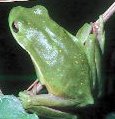|
Green Treefrog
Hyla cinerea
(click images to enlarge)
 Appearance: This is a moderately large treefrog, ranging in size from 3 to 6 cm. (1.25 to 2.25 in.). Green Treefrogs are most easily distinguished by a light-colored lateral stripe, extending from the upper lip along each side to the groin. This line may be pearly white, pale yellow, or, occasionally, entirely absent. Green Treefrogs are generally green in coloration, although this color may vary from dark olive-brown to pale yellow. Green Treefrogs may frequently be identified by the presence of small, yellow spots on the Appearance: This is a moderately large treefrog, ranging in size from 3 to 6 cm. (1.25 to 2.25 in.). Green Treefrogs are most easily distinguished by a light-colored lateral stripe, extending from the upper lip along each side to the groin. This line may be pearly white, pale yellow, or, occasionally, entirely absent. Green Treefrogs are generally green in coloration, although this color may vary from dark olive-brown to pale yellow. Green Treefrogs may frequently be identified by the presence of small, yellow spots on the dorsum, a feature which may distinguish otherwise unmarked individuals from the similar Squirrel Treefrog (Hyla squirella). dorsum, a feature which may distinguish otherwise unmarked individuals from the similar Squirrel Treefrog (Hyla squirella).
Habits and Habitat: Green Treefrogs are drawn to open, damp areas like cattle tanks, pasture ponds, slowly flowing canals, lakes and streams, especially among emergent and floating vegetation.  This is a common backyard species can frequently be seen at porch lights, where individuals may gather to forage for insects. During the day, Green Treefrogs may be found resting on pond-side, emergent vegetation. This is a common backyard species can frequently be seen at porch lights, where individuals may gather to forage for insects. During the day, Green Treefrogs may be found resting on pond-side, emergent vegetation.
Vocalization: The Green Treefrog call has been described as a series of "quonks" or as a "queenk-queenk-queenk" with a nasal inflection. Green Treefrogs can be heard chorusing from early February to late summer in Florida, although in the more northerly parts of their range reproduction begins later in the spring. They call most frequently on warm, humid, overcast nights. Chorus:  (Includes Spring Peeper). (Includes Spring Peeper).

Reproduction/Egg Description: Green Treefrogs lay their eggs anytime from early spring to midsummer. The complement of 400-600 eggs is laid in numerous clusters of 40-100 each. The eggs may float as a surface film, or often adhere to floating or emergent vegetation. Eggs hatch in 4-6 days and tadpoles metamorphose in about 2 months.
Distribution and Abundance: Green Treefrogs are one of the most common and abundant treefrogs of the southeast. They occur throughout the Deep South, ranging from East-central Texas up the Mississippi Valley to southern Illinois, and around the Gulf Coast and up the Atlantic Coast to the Coastal Plain of the upper Mid-Atlantic States. Isolated colonies also exist in south-central Missouri.
SE ARMI Index Sites: Everglades National Park, Okefenokee National Wildlife Refuge.
|